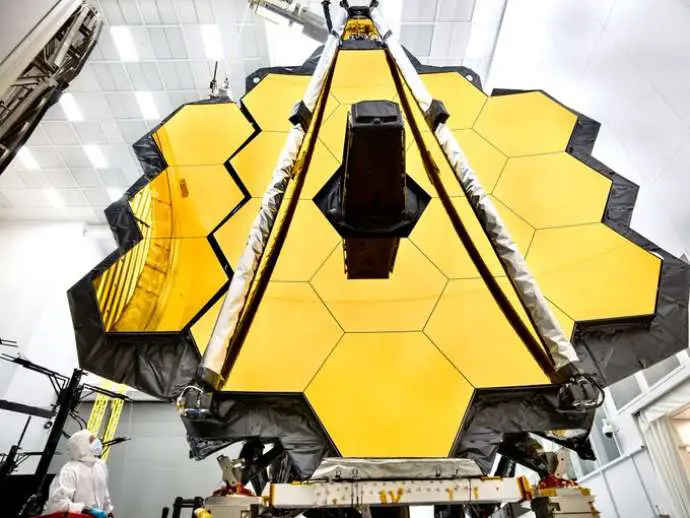Časoris is an online newspaper aimed at children. Each week we’ll take an article and post it here as a Slovene-English dual text.
Najnaprednejši teleskop v vesolju
The most advanced telescope in space
Written by Sandra Hanžič, translated by JL Flanner & G Translate
Božične praznike smo večinoma praznovali mirno.
We mostly celebrated the Christmas holidays peacefully.
Ampak napeto pa je bilo v vesoljskem centru v Francoski Gvajani, iz katerega so prav na božični dan izstrelili teleskop James Webb.
But it was tense at the space centre in French Guiana, from where the James Webb telescope was launched on Christmas Day.
Ta bo nadomestil Hubblov teleskop in nam prinesel še boljši pogled v vesolje.
This will replace the Hubble Space Telescope and give us an even better view of space.
Teleskop je v vesolje popeljala raketa Ariane 5. Ko se je od nje ločil, je upravljanje prevzela ameriška vesoljska agencija NASA.
The telescope was launched into space by the Ariane 5 rocket. When it separated from it, the US space agency NASA took over.
Orbito bo dosegel čez približno tri tedne. Končni cilj pa je od Zemlje oddaljen približno 1,5 milijona kilometrov.
It will reach orbit in about three weeks. The final destination is about 1.5 million kilometres from Earth.
Nato bo pol leta trajalo, da bo razgrnil svoj sončni ščit in glavno, 6,5-metrsko ogledalo. Pripravil bo inštrumente za fotografiranje nebesnih teles in za spektroskopijo ter se ohladil.
It will then take half a year for him to unfold his sun shield and main, 6.5-meter mirror. He will prepare instruments for photographing celestial bodies and for spectroscopy, and cool down.
Kaj bo njegova naloga?
To ensure that #NASAWebb is in prime condition for its next major step, our team has decided to focus today on learning more about how Webb behaves in space. Sunshield tensioning has been moved to no earlier than tomorrow, Jan. 3. https://t.co/o5ZvSXdXZV #UnfoldTheUniverse pic.twitter.com/dY8Oi5U1tv
— NASA Webb Telescope (@NASAWebb) January 2, 2022
What will its task be?
Preučeval bo nastanek vesolja vse do 200 milijonov let po velikem poku. Ta se je zgodil pred 13,8 milijarde let.
It will study the formation of the universe up to 200 million years after the Big Bang. This happened 13.8 billion years ago.
Poleg tega bo odkrival planete zunaj Osončja in iskal sledi življenja.
In addition, it will discover planets outside the Solar System and look for traces of life.
Znanstvenik John C. Mather, ki sodeluje pri projektu, je že pred leti dejal, da je zelo velika verjetnost, da bi nekje v vesolju našli življenje.
The scientist John C. Mather, who is involved in the project, said years ago that there is a very high probability that they would find life somewhere in space.
»Ne smemo biti presenečeni, če bomo življenje našli na Marsu, Evropi, Titanu ali drugje v Osončju in če bomo zaznali kisik okoli planetov, ki krožijo okoli druge zvezde.«
"We should not be surprised if we find life on Mars, Europe, Titan or elsewhere in the Solar System and if we detect oxygen around planets orbiting another star."
Teleskop so začeli graditi leta 2004, zaradi zapletov pa so ga dokončali šele konec lanskega leta.
Construction of the telescope began in 2004, but due to complications it was not completed until the end of last year.
Projekt se je podražil za trikrat od prvotnih načrtov in je danes vreden skoraj 9 milijard evrov.
The cost of the project has risen three times since the original plans, and is worth almost 9 billion euros today.
Read more stories and improve your Slovene at Časoris, while all our dual texts can be found here.






